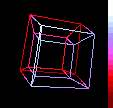Honeybees, like all other living creatures, have methods of communicating within their species, and to others as well. The honeybees buzzing and sting apparatus are both well known. Certainly their use of pheromones1 have been studied by many scientists, and their waggle dance, and sensitivity to ultraviolet and polarized light was reported by K. von Frisch in 1965. However, it wasn't until 1995 when Barbara Shipman, a mathematician at the University of Rochester, linked the Waggle Dance of the honeybee to Quantum Mechanics2.
Ms. Shipman who is, or was at this writing, now an associate professor at UTA was studying a form of geometrics, for her doctoral thesis, that defines curves or shapes of surfaces - some of which can have six or more dimensions. The higher dimensional objects can't be visualized so they are often projected onto a two dimensional space (like a paper). Your shadow on a wall is a two dimensional representation of a three dimensional object (you).
The two dimensional representation of a six dimensional flag manifold³ turns out to be a hexagon (like the comb in a beehive) which is interestingly coincidental, however, Ms. Shipman, upon further study, found curves that were an exact duplicate of the curves in the honeybees recruitment dance (the dance made by bees to recruit other bees to a source).
When a honeybee dances to communicate the location of a source, and the distance from the hive to the source reaches a certain point, the bee will change from a waggle dance to a circle dance, which employs short straight line segments on the sides of the loops to define the shorter distance. Upon continued examination of the flag manifold Ms. Shipman discovered that when the curves change dramatically, and reach a certain value they also change to straight line segments.
The flag manifold is helpful, to physicists, in solving mathematical problems with quarks4, and Ms. Shipman believes it is more than coincidental that it appears in both the mathematics of the honeybee dance, and in the mathematics of quarks. She suspects the honeybees somehow sense the quantum world of quarks.
Not the smallest wonder of it all is how the honeybee, a small insect, could come upon such an elaborate method of communicating information. Their brains are so small that much of what they do is instinctive rather than learned. Consider the honeybees sensitivity to ultraviolet and polarized light, their ability to navigate by triangulation using the sun, employing a visual odometer, and by using landmarks.
Further information can be found in an article writen by Adam Frank in the Nov. 1997 issue of Discover, and an airing on NPR, December 5, 1997 of a discussion with Ms. Shipman (sources from which much of this article was gleaned).